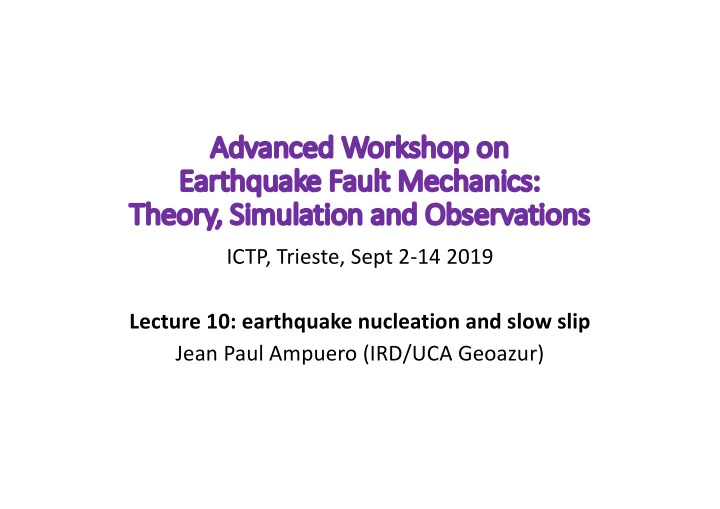

Adv Advanced anced Worksho shop p on n Ea Earthquake Fa Fault Mechanics: The Theory, , Simulation on and Observation ons ICTP, Trieste, Sept 2-14 2019 Lecture 10: earthquake nucleation and slow slip Jean Paul Ampuero (IRD/UCA Geoazur)
How do earthquakes start? Do small and large earthquakes start the same? Predictive value of earthquake onset and foreshock sequences? • Seismological observations • Laboratory observations • Earthquake nucleation models
Sei Seism smological al obser servati tions s of of earthquake nucl cleation on
Seismological observations Nucleation duration (s) Ellsworth and Beroza (1995) Beroza and Ellsworth (1996) Seismic moment (Nm)
Seismological observations related to early warning research 1/# $ ∼ instantaneous frequency Nakamura (1988) Simons et al (2006)
Seismological observations related to early warning research Magnitude dependence of early dominant period Allen and Kanamori (2003)
Seismological observations of earthquake initiation Peak ground displacement (Pd) grows exponentially. Growth rate depends on magnitude Colombelli et al (2014)
Seismological observations of earthquake initiation Evidence for universal earthquake rupture initiation behavior Meier et al (GRL 2016) Study based on short-distance recordings of shallow crustal earthquakes Take ground displacement growth as proxy for STF Growth initially compatible with self-similar pulse and crack models Slower growth after ~1s, M~5 Meier et al., 2016, GRL
The Hidden Simplicity of Large Subduction Earthquakes Meier, Ampuero and Heaton ( Science 2017) On average (median), all STFs can be scaled to a very simple, quasi- triangular shape
Characterizing large earthquakes before rupture is complete Melgar and Hayes ( Sci Adv 2019) “early in the rupture process—after about 10 s—large and very large earthquakes can be distinguished”
Data colored by ratio of event rupture duration and typical rupture duration for its magnitude Same figure but for simulation data based on the scalable STF model of Meier et al (2017) Meier et al (2019, in prep)
Seismological observations A Mw3.9 earthquake in Alaska triggered by Love waves from the April 11, 2012 Mw 8.6 Sumatra earthquake Tape et al (2013)
Seismological observations Nucleation phase of the Mw3.9 Alaska triggered earthquake Tape et al (2013)
June 2018 Slow and fast earthquakes (regular and low-frequency events) at the base of the seismogenic zone in the Minto Flats fault zone, central Alaska
Bear Encounters with Seismic Stations in Alaska and Northwestern Canada Tape et al (SRL 2019) Seismic vaults and equipment enclosures in Alaska visited by curious bears
Tape et al (Nat Geo 2018)
Seismological observations Foreshock sequences Dodge et al (1996)
Seismological observations Foreshock sequence of the 2011 Tohoku earthquake Kato et al (2012)
2014 Iquique earthquake + foreshock sequence m a IPOC stations Regional catalog by CSN Chile Seismic coupling by Metois et al (2013)
2014 Iquique foreshock sequence m a
La Labo boratory observations ns of of rupture nucl cleation on
Laboratory experiments Ohnaka (1990)
Laboratory experiments Nielsen et al (2010)
Laboratory experiments Laboratory foreshocks Rubinstein et al (2007)
Laboratory experiments Foreshocks promoted by aseismic slip McLaskey and Kilgore (2014)
Ra Rate-an and-st state models of of earthquake nucl cleation on
Nucleation sizes in rate-and-state friction Different nucleation styles depending on a/b (ratio of viscous to weakening effects in rate-and-state friction) Localized slip at low a/b Expanding slip at high a/b Maximum nucleation size: Minimum localization size: ! " = $! % ! ' = $! % − ) * & %& * % = ! " % − ) ,- " ! + = "./ 0 = "./ ! " Rubin and Ampuero (2005)
Nucleation size in rate-and-state friction From lecture 2: crack in static equilibrium of size ! Larger %& ' ( ! = 2-" + /Δ0 ) " # = )* = " + à velocity jump Rate-and-state behaves as slip-weakening near the rupture front, with equivalent properties: ) " + ≈ 1 8 2 345 ln Slip / L 8 ∗ ; Stress drop Δ0 ≈ 3 − ! 4 ln ; ∗ à Crack size: 3 ) ! ≈ -5 3 − ! ) = 5 < 34 Rubin and Ampuero (2005)
Example: brittle asperity isolated in a creeping fault zone An isolated brittle asperity (v-weakening) within a creeping fault (v-strengthening). Constant slip velocity V background imposed far from the asperity. Log(V/ V background ) Time normalized by Dc/ V background Position along-strike
Example: brittle asperity isolated in a creeping fault zone Maximum seismic slip velocity slow slip aseismic Asperity size
Barbot (2019) Fault size / nucleation size
Barbot (2019) Fault size / nucleation size
Cattania (2019) Fault size / nucleation size
Rate-and-state models of slow slip and foreshock swarms Conceptual model of slow slip event + foreshocks leading to a large earthquake Numerical model (QDYN) of slow slip event + small earthquakes/tremors
Tape et al (Nat Geo 2018)
Ra Rate-an and-st state models of of sl slow sl slip and tremor or
Migrating swarms: asperity interactions mediated by creep transients It triggers a migrating aseismic transient The asperity breaks Influence radius
Migrating swarms: asperity interactions mediated by creep transients Cascading failure of a population of brittle asperities à Tremor swarm Quasi-dynamic 3D simulations with K. Ariyoshi (JAMSTEC)
Sl Slow slip p and nd tremor migr gration n pa patterns ns 7 km/day Days Non-volcanic tremor migration patterns in Cascadia, USA Tremor migrates slowly along strike ( ~10 km/day) tracking the front of the slow slip event Episodic tremor swarms propagate backwards, faster ( ~ 100 km/day) Houston et al (2010)
Simulations of slow slip and tremor QDYN model of slow slip and tremor Rapidal Tremor Reversals observed in Cascadia Houston et al (2010) ≈8 km/day Model Luo and Ampuero
Recommend
More recommend